Growing your own Zucchinis is exciting and rewarding if you take good care. But discovering rot in the Zucchini can be frustrating. You are not alone if you have this issue.
There are three main types of rot that can affect Zucchini plants: Stem rot, Root rot, and Blossom End rot. Reasons are watering issues, poor soil, improper pH levels, calcium deficiency, nutrient imbalance, pest infestations, and fungal diseases. Identify the rot and its underlying causes to control the rot.
The reasons behind each rotting are different. Are your Zucchinis rotting, but can’t identify the type? This article delves deep into Zucchini’s different types of rot, their causes, signs, and ways to resolve it.

Overview of rotting in Zucchini plant
Zucchinis are famous summer squashes. Their main attraction is easy care and rapid growth.
Despite proper care and maintenance, Zucchini plants can become victims of several rots, like Zucchini Stem rot, Zucchini Root rot, and Zucchini Blossom End rot.
As a Zucchini grower, you must understand the different types of rot in Zucchini and their underlying causes to provide the plant with the proper treatment and ensure successful Zucchini cultivation.
Types of rot in Zucchini plant: Stem Rot, Blossom End Rot, and Root Rot
There are three primary types of rot in the Zucchini plants:
Stem Rot
The stems become soft and discolored, eventually leading to ruins.
Vine borer infestation is the main cause.
Rotting stems further get accelerated by overwatering, poor air circulation and drainage, and contamination.
Blossom End Rot
Blossom End Rot creates dark lesions at the Zucchini fruit’s base.
The rotting results from calcium deficiency, overwatering, and fluctuations in the soil moisture.
Root Rot
Common causes are overwatering and poor drainage.
The roots begin to decay when they stay moist for too long.
Root rot can weaken the plant’s ability to absorb nutrients and moisture, leading to stunted growth and death.
Apart from these three types, I’ve also come across two more forms of rot: Fusarium rot and Fruit rot.
Let’s discuss each of them in detail to understand better the underlying causes of rot in Zucchini and how to resolve them.
Understanding the problem: Zucchini Stem Rot
In this rotting, the stems of the Zucchini plant will begin to rot.
If you inspect your Zucchini plant regularly, you will find that the stems at the plant base are rotting suddenly.
You will find a mushy skin or a white substance along the base.
Various pathogens and fungi will damage and rot the stems of the Zucchini plant.
These pathogens enter through some open wounds on the stems, or pests carry them.
2 common causes of Zucchini stem rot are:
- Squash vine borers
- Gummy stem blight
Impact of pests on zucchini stem rot: Squash vine borers and larvae infestation
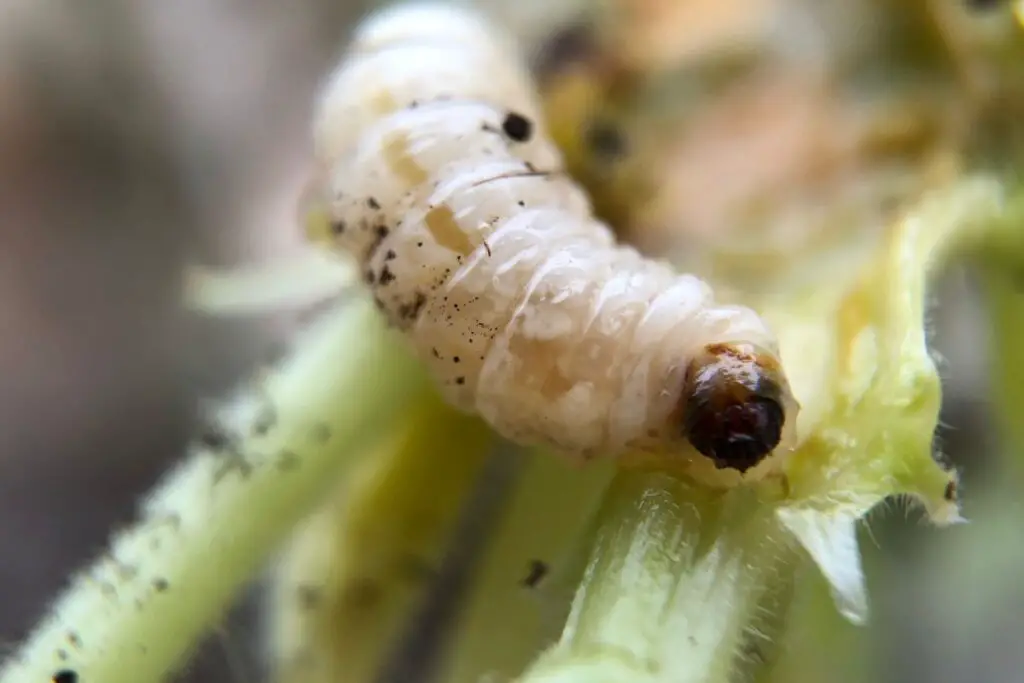
Squash Vine Borer infestation is one of the most common reasons for Zucchini Stem Rot.
Stems will begin rotting, and this rot will slowly reach the plant base.
Stem rot can quickly deteriorate the condition of your plant.
The vine borers are the larvae of a type of moth.
The moths are not the ones to destroy your Zucchini; their larvae are responsible.
The moth stays at the plant base and lays eggs.
Once these eggs hatch and the larva emerges, it will head down into the stems, feed on them, and finally rot them.
These borers create tunnels inside the stems or stalks of the Zucchini plant and feed on them.
Once the plant is infected, rotting will reach the plant base, making it more difficult to recover.
From the end of spring to midsummer is the ideal time for the moths to lay eggs.
Signs of infestation
A few years back, my Zucchini plant’s stems were rotting.
I considered the reason to be overwatering.
But despite addressing the watering issues, I did not find any progress.
Upon research, I learned about Stem rot and its signs and started closely looking for the infestation signs. Here are the signs I noticed:
- Zucchini leaves are suddenly wilting despite proper watering and soil type.
- Sawdust-like residue at the plant base. These are the residues the larvae chewed up as they burrow into the stems. It indicates your plant is already infested.
- Mushy stems at the bases of the Zucchini plant
Once you find these signs, try to check for the intrusion of these unwanted guests.
You will find wasp-like bugs with orange or red markings and shiny green wings.
The bugs are oval-shaped with brown circles.
I have also checked the stems by cutting a few of them open.
I found a larva inside. Unfortunately, I had to dispose of this plant.
But thankfully, no other plant was infected.
At this point, you are already late in determining the cause, and it becomes very challenging to save the plant.
Effective Zucchini Pest Control Measures
If the plant has started rotting, you are too late to save your Zucchini plant.
But if you check your plant, identify the issue, and act quickly, you can save your plant from Stem rot and infestation.
Remove the pests yourself from the Zucchini.
This is possible only if the larvae have started their journey into the stem, but it isn’t long enough.
The sawdust residues around the Zucchini plant base indicate they have chewed some Zucchini.
Cut open the stem with a sharp knife and remove the larvae.
After this, do not keep the stem open. Wrap an aluminum foil or soil to close the cut.
It can stop the plant from making new roots for some time.
Instead, you can poke some chicken wire into the stem around the entry point.
Add pepper to the Zucchini soil.
Vine borers detest pepper.
Add some around the soil, mainly near the plant base.
They will leave your Zucchini immediately.
Catch the pests at night
The adult moths rest at the plant base, and that’s when they lay eggs.
Come out at night to catch these wasps and discard them from your Zucchini.
Also, remove the eggs, if any.
It will stop the larvae from coming out and destroying your plant.
Use fly traps for your Zucchini plant
Putting yellow sticky traps near the Zucchini plant will trap these wasps when they are flying.
Once they are stuck to the sticky traps, they won’t be able to reach the plant base or lay eggs.
Trap the adults in sweet drinks
Make a sweet drink in a yellow bowl close to the Zucchini plant.
These moths can get attracted to the drink and stop there for the drink.
So, they won’t be laying eggs on the plant base. Catch and discard them.
Maintain your Zucchini plant health
Stem rot can accelerate by overwatering, poor drainage, and air circulation.
Make sure to water the Zucchini plant whenever the few inches have dried.
The soil should be well-drained so that excess water doesn’t remain stagnant.
Zucchini Stem rot caused due to Plant Disease
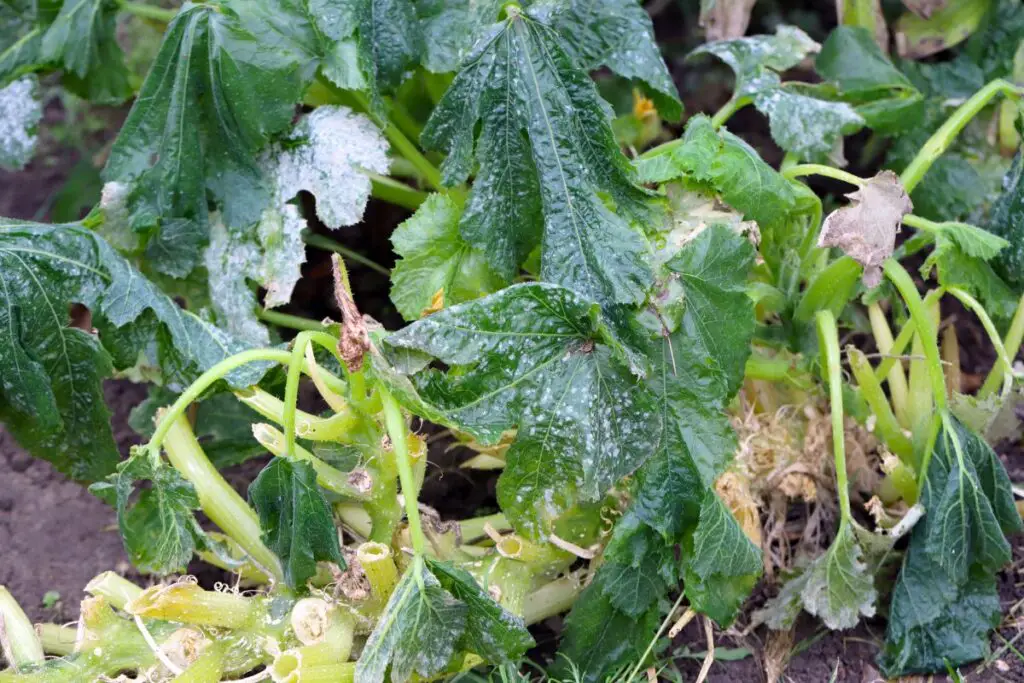
Gummy Stem blight, also stem canker or black rot, can severely rot the Zucchini stems.
The bacteria Didymella bryoniae causes Gummy Stem blight, infecting Zucchini plants by entering through fresh open wounds on the stems or vines.
Once the bacteria enters and starts spreading, the stem will turn brown and expose a sticky amber-colored liquid.
Over time, the disease will take up the remaining parts of the plant, leading to stunted growth, dark rotten marks on the fruit, and death.
The pathogen thrives in high humidity and warm temperatures.
The disease’s symptoms on the leaves are difficult to identify because leaves are the first to display signs for all types of issues.
By the time you identify, the rotting will quickly spread to the stems.
Gummy stem blight occurs mainly due to:
- Overhead watering
- Lack of air circulation
As I mentioned, the pathogen thrives in high humidity.
While performing overhead watering in the Zucchini plants, the leaves remain wet.
Also, insufficient air circulation doesn’t let the moisture on the leaves dry out.
Together, these two problems can increase the humidity, and the pathogens start getting attracted toward your Zucchini plant.
Zucchini Disease Control
To treat the disease, isolate the plant soon.
Prune the damaged and infected leaves to prevent the spores from spreading.
Use some neem spray or organic bio-fungicide like Actinovate to prevent the disease from spreading to the nearby Zucchinis.
Avoid overhead watering.
If you have already, ensure the leaves dry out faster.
Keep at least 2-3 feet distance between each plant.
It will ensure good airflow, allow the leaves to dry faster, and prevent spores from spreading.
Keep a close eye on the Zucchini plants and see if any other plant shows similar signs.
To prevent the disease:
- Try to maintain proper air circulation by planting each Zucchini 2-3 feet apart.
- Avoid overhead watering.
- Always water the Zucchini plant from the base, and avoid watering the leaves.
Looking for gardening supplies? We have tested 100's of products before recommending them to you guys. Check out our best pick below:
| Image | Gardening Supplies | Best Price? |
|---|---|---|
 Top
Top Top
Top | Raised Garden Bed Kit | Check On Amazon |
 | XLUX Soil Moisture Meter, Plant Water Monitor, Soil Hygrometer Sensor for Gardening, Farming, Indoor and Outdoor Plants, No Batteries Required | No Results |
 Top
Top Top
Top | 82 Pcs Garden Tools Set and Extra Succulent Tools Set | Check On Amazon |
 | Joeys Garden Expandable Garden Hose with 8 Function Hose Nozzle, Lightweight Anti-Kink Flexible Garden Hoses, Extra Strength Fabric with Double Latex Core, (50 FT, Black) | No Results |
 Top
Top Top
Top | Dual Chamber Compost Tumbler | Check On Amazon |
 Top
Top Top
Top | Sunnyglade Plant Stakes | Check On Amazon |
 Top
Top Top
Top | Organic Cold Pressed Neem Seed Oil | Check On Amazon |
 Top
Top Top
Top | Mighty Mint Gallon :-Insect and Pest Control Peppermint Oil | Check On Amazon |
 Top
Top Top
Top | Scotts DiseaseEx Lawn Fungicide | Check On Amazon |
 Top
Top Top
Top | Jacks Classic 20-20-20 All Purpose Fertilizer | Check On Amazon |
 Top
Top Top
Top | 30,000 Seeds Pollinator Attracting Wildflower Mixture | Check On Amazon |
 Top
Top Top
Top | Survival Vegetable Seeds Garden Kit-Over 16,000 Seeds | Check On Amazon |
Zucchini Blossom End Rot: Causes and Treatment
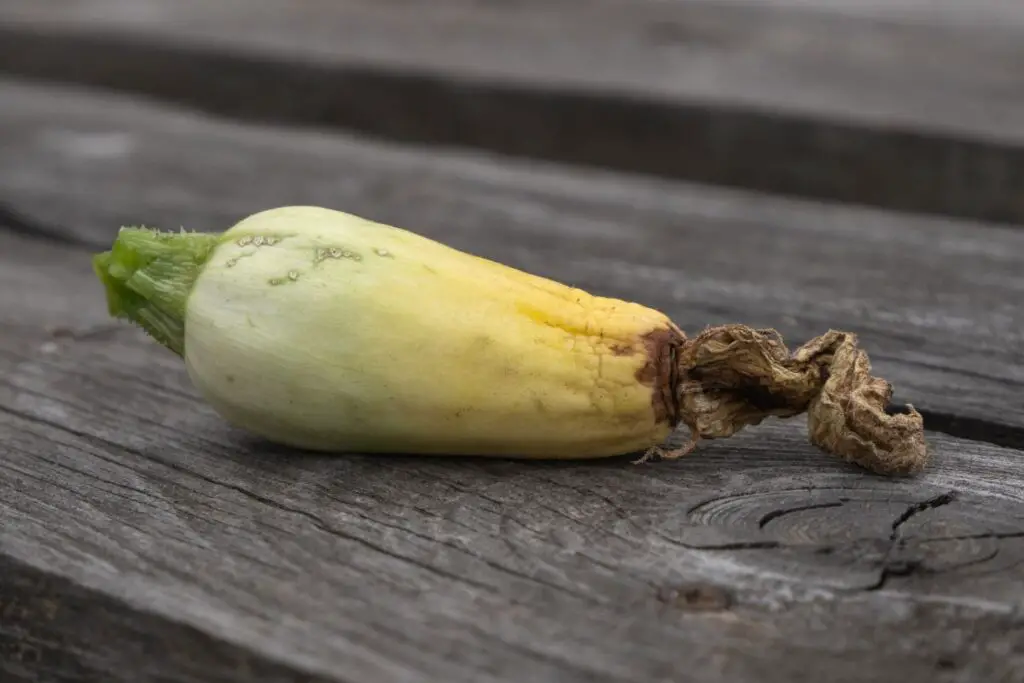
Blossom End rot begins with cell wall degradation, softening the flesh above the flower.
The scientific name of this rot is Apical Necrosis.
Apical means Apex or Blossom End, and necrosis means localized death of the living tissue.
The tissue will die once this rot starts progressing in your Zucchini plant.
The rotting will start at the lower side of the fruit, around 2-4 inches.
The signs of Blossom end rot are:
- Discolored sunken spot at one end of the fruit
- Yellow fruit turns brown and then black
- The rotting area becomes soft, mushy, and moldy
Sometimes, the unrotten part of the Zucchini will look good, and you might get tempted to remove the bad part and eat the good part.
Unfortunately, the fruit’s taste and fragrance will be terrible, and the texture will deteriorate.
The reasons behind the Blossom End rot are:
- Calcium deficiency
- Improper soil pH and nutrient imbalance
The good news is that you can save your plant from further rotting once you identify the right cause. Now, let’s learn them in detail.
Causes and Effects of Calcium Deficiency in the Zucchini Plant
Every plant, including Zucchini, will require three essential nutrients: nitrogen, phosphorus, and potassium.
Along with these macronutrients, they also require some micronutrients, like calcium, magnesium, and sulfur.
Out of these, calcium deficiency causes the Blossom End rot in the Zucchini plants.
Calcium (as calcium pectate) helps build the cell walls of the Zucchini fruits.
The calcium and pectin bind to make salts that help the cell walls stay strong and turgid.
Calcium also helps regulate many cell processes and makes the Zucchini plant more resistant to pest infestations.
A shortage of calcium can harm the Zucchini plant’s roots, leaf tips, and shoots, potentially causing growth distortions.
Calcium deficiency due to uneven moisture supply and its impact on Blossom End rot
Most soils contain calcium, but to receive its benefit, your Zucchini should be able to absorb it from the soil through roots and then get transported to the other plant parts and tissues via the xylem.
Water scarcity is one of the common reasons that hinders calcium absorption, causing cell breakdown.
Zucchini’s root system with a taproot 3 feet long needs regular and deep watering so that the moisture and nutrients can easily get transferred to the other plant parts.
Since the Zucchini flowers and fruits are the farthest from the roots, they are the last to receive nutrients and the first to suffer.
Overwatering does the same thing.
It suffocates the roots, for which the Zucchini struggles to uptake the nutrients from the plant and suffers from Blossom End rot.
Calcium deficiency due to Root damage and Blossom End rot
When the roots of the Zucchini plant are damaged for reasons like rotting or physical damage while transplanting, the plant fails to uptake nutrients, including calcium.
Roots can rot due to prolonged exposure to moisture, where they start decaying at one point.
The problem damages the root so much that it not only leads to Blossom End rot but also Root rot disease.
Together, they can make your Zucchini plant’s condition more devastating.
Roots can also be damaged due to physical damage during transplantation.
It becomes difficult for the plant to uptake calcium and other nutrients, causing Blossom End rot.
Another condition where the chances of root damage are high is when you plant them too close to each other.
The roots need space to grow flexibly.
But when the Zucchinis are close, the roots start entangling with each other, causing root damage.
Pests like nematodes eat up the plant roots and damage them, hindering the calcium and other nutrient uptake and causing Blossom End rot.
Once the Blossom End rot has started in the Zucchini fruits, you cannot stop it from progressing.
But you can fix the conditions leading to the rot and save the rest of the plant.
Calcium deficiency due to Over-fertilization
Adding excessive nitrogen to the soil also hinders calcium uptake, leading to Blossom End rot.
Excessive nitrogen also hinders fruiting and flowering and encourages only foliage growth.
Also, avoid excessive use of Epsom salt as a fertilizer while the plant suffers from Blossom End rot.
It is magnesium sulfate. Excess amounts of Epsom salt can also inhibit calcium uptake.
Soil testing and calcium levels
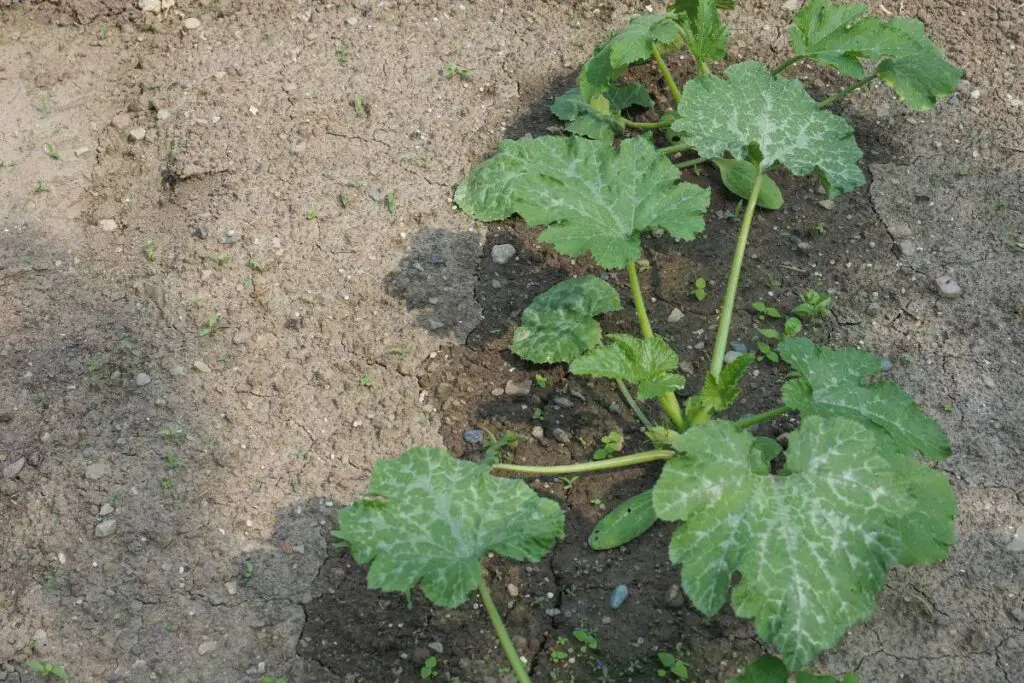
If you are doing everything correctly but still witness Blossom End rot, consider testing the soil once to understand its calcium levels.
If the levels are low, you will understand the reason behind the Blossom End rot.
It would be better to do this before you plant the Zucchinis.
Then, you can adjust the soil and prevent the rotting from occurring.
Calcium sources and fertilizers for Zucchini
It is common for some soils to have low calcium levels, especially when you water daily.
Nutrients can deplete over time.
But you can quickly fix it and treat and prevent the rotting.
Add organic matter to the soil.
It will make the soil fertile by adding lots of nutrients.
Fertilizing begins a few weeks after adding the organic matter.
Use the correct fertilizers, especially those containing calcium as a micronutrient.
Choose a balanced liquid fertilizer with NPK 10-10-10.
Dilute it with water and apply every 2-3 weeks. If you use pellets, scatter some at the time of planting and again in the midsummer.
Avoid using fertilizers containing high nitrogen levels.
Do not use Epsom salts to manage calcium levels.
Instead of curing the rotting, it will worsen the condition.
Incorporating calcium supplements
Some gardeners already fertilize and still face the same issue.
Try changing the fertilizer and use the one that can provide adequate calcium.
Some fertilizers can alter the pH level.
Another option is adding calcium supplements into the soil to increase the calcium levels.
You can add gypsum, calcium sulfate, and calcium chloride into the soil.
It will increase the calcium levels in the soil without altering the pH levels.
Other options are wood ash, garden lime, and bone meal.
Zucchini Watering techniques and soil type
Since water scarcity disturbs the nutrient uptake, including calcium, ensure the soil remains evenly moist.
Zucchinis love infrequent and deep watering.
But if the weather is too hot, you must water them frequently.
The top few inches should stay dry when you water the Zucchini plant.
Don’t let the entire soil dry out.
Consider mulching for water retention.
Since mulch traps moisture, you don’t have to consider frequent watering.
You can also try a drip irrigation method.
Be wary of overwatering.
Barren or compact soil is not suitable for Zucchinis.
Soil should be well-drained, well-retained, and fertile.
Treating root damage in the Zucchini plants
Dealing with Zucchini root damage is challenging, especially when the injury is more than 40-50%.
Consider checking the roots of the Zucchini plant once.
You can remove the damaged roots and replant the plant if the damage is less.
Be careful during the transplantation.
If you have Root rot, spray some fungicide to stop the infection from spreading. Avoid overwatering and any further stress.
If you have nematodes, use some Nematophagus Fungi to kill them.
Use them as a biocontrol agent in the soil. Consider crop rotation to prevent nematodes from attacking your Zucchini.
Impact of soil pH and Nutrient Deficiency
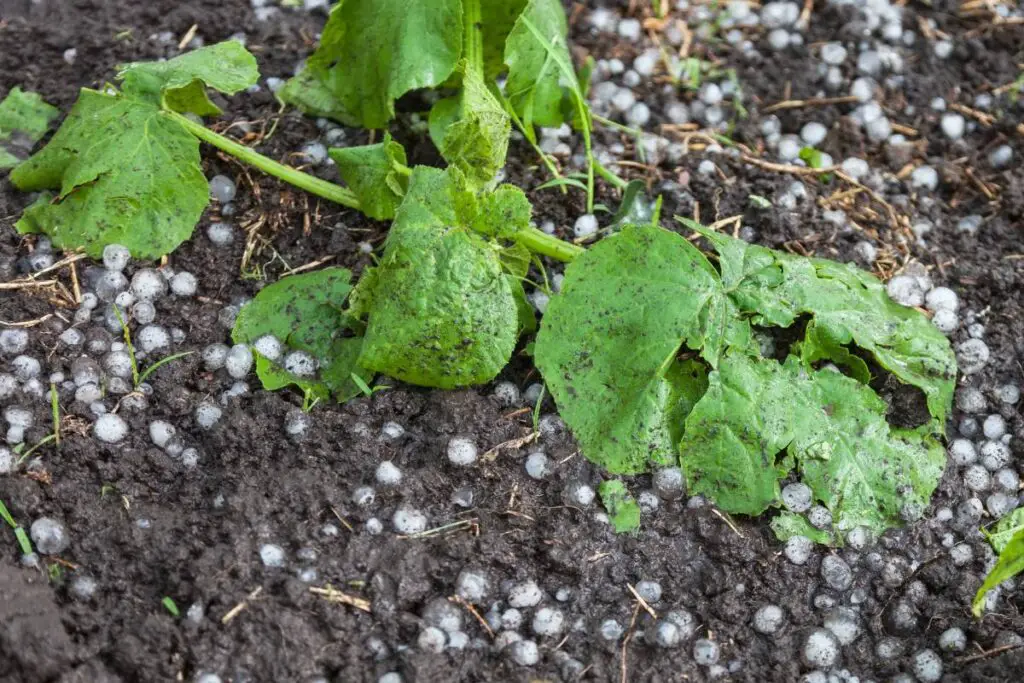
Improper soil pH levels can be very harmful to the Zucchini plant.
The pH levels in the soil determine the nutrient availability in the plant.
Zucchinis enjoy a pH level between 6.5 and 7.0.
It allows the Zucchini to retain the nutrients they need in a slightly acidic and neutral environment.
If the pH levels are improper, the nutrient (including calcium) retention and uptake will fail, leading to Blossom End rot.
As I said, some fertilizers can alter the pH level and hinder calcium uptake in the Zucchini plants.
You must adjust the pH first to fix the rotting for the improper pH levels.
Adjusting Zucchini soil pH levels
Use a pH meter to measure the pH level of the Zucchini soil.
The Zucchini soil pH should stay between 6.5 and 7.0.
Add garden lime to adjust the pH level if the soil seems acidic.
Add 3-4 ounces of the garden lime per square yard.
If the soil is alkaline, add sulfur. Based on the soil structure, 6-8 ounces per square yard would suffice.
Check for instructions mentioned in the package.
Root rot in the Zucchini Plants
Root rot in Zucchini is due to excessive moisture levels in the soil.
It happens due to overwatering, poor drainage in the soil, or compact soil.
Root rot is caused by the soil-inhibiting pathogens called Pythium and Phytophthora.
The disease is mainly seen when you plant the Zucchinis for a fall harvest, followed by a damp and cool climate.
Zucchini plants are prone to Root rot when they remain surrounded by water for prolonged periods.
Role of overwatering and poor drainage in the Zucchini plants
When you overwater the Zucchini plant, the roots suffocate and fail to send moisture and nutrients to the other parts.
For this, the Zucchini will show several signs like wilting and yellowing.
If you ignore these signs, the plant will become stressed over time.
And that’s when the soil-inhibiting pathogens will attack your Zucchini and start decaying the roots.
The same happens when you use soil that is poor in drainage or too compact.
The soil keeps holding the excess water, which must be drained.
As a result, the roots stay wet for prolonged periods, leading to root rot.
Root decay symptoms
When the Zucchini suffers from root decay, the leaves are to show the initial signs, like yellowing or defoliation.
Over time, you will receive a foul smell from the plant base.
It’s an obvious sign that the roots have decayed under the ground.
You have to dig out the plant and check the roots for better confirmation.
The decayed roots are brown and mushy, and the white firm roots are healthy.
Consistent irrigation for Zucchini to treat Root rot
You must keep the Zucchini’s soil consistently moist.
It should neither be too wet nor too dry.
Instead of following any strict routine, check the soil moisture daily before watering.
Whenever the top few inches have dried, you can go for watering.
It is more critical when you have planted the Zucchinis for the fall harvest, and the weather gets cool and damp.
As for the soil, use the right recipe that can make the soil well-drained, well-aerated, and fertile.
Incorporating organic matter into the soil can solve the soil issue.
It can improve drainage, retention, and fertility of the soil.
Keep checking the soil with your finger.
If you feel confused, you can use a moisture meter to understand the moisture level.
Poor pollination and its role in Fruit rot
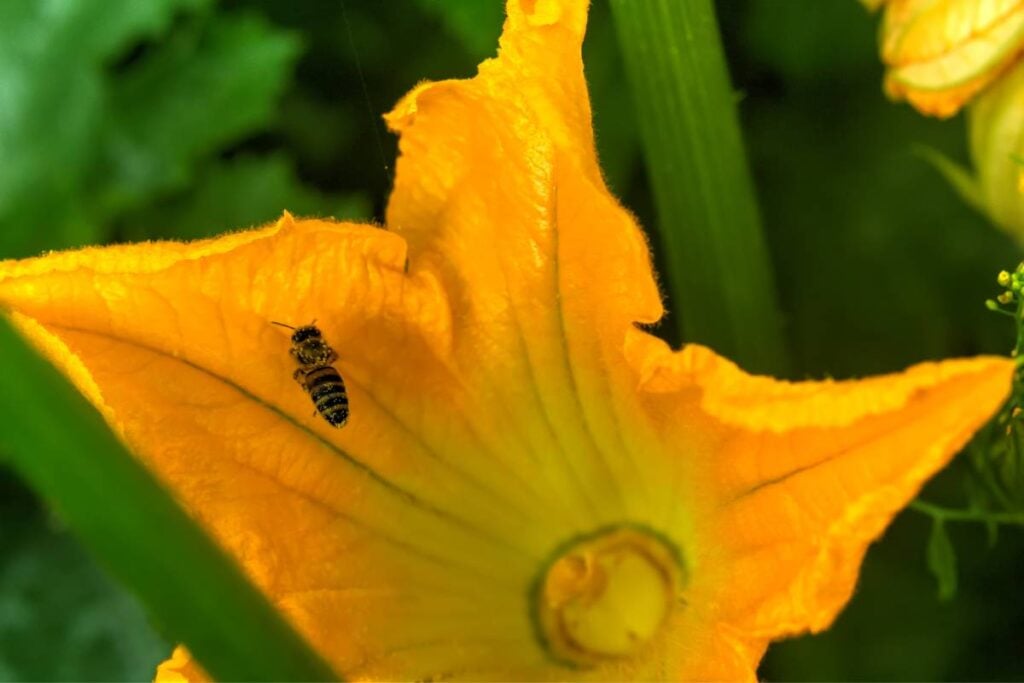
Some people confuse Blossom End rot with Fruit rot.
In a Blossom End rot, the one end of the Zucchini fruit will start rotting.
If the whole fruit starts rotting, it is due to the lack of pollination.
It is not related to Blossom End rot.
Zucchini plants rely on pollination.
They can self-pollinate, so they have both male and female flowers in the same plant.
But, you need natural agents to transfer the pollen from the male to the female flower.
Additionally, the pollen should be enough and needs to be transferred correctly.
Insufficient pollen transfer to female flowers can cause growing fruits to develop wrinkles and rot.
Take control of the Zucchini pollination
You can control poor pollination by hand-pollinating the Zucchini flowers.
Take a cotton or paintbrush and identify the male and female flowers.
The male flowers will have a single stamen at the center, whereas the females have baby Zucchini or swelling at the base.
Rub the cotton swab or the paintbrush against the male flower’s stamen, then rub them again against the pistils inside the female flowers.
Repeat this for all the flowers.
Once you receive fresh fruits, Blossom End rot will be under control.
Fusarium Fruit rot in Zucchini plants
Caused by the pathogen Fusarium solani, Fusarium crown rot can rot the Zucchini plants from the base, mainly infecting the crown.
The disease leads to the death of your Zucchini plant within a few days of infection.
The pathogen is seed-borne, lives in the soil, and increases on the old plant debris.
Common causes are:
- Poor drainage
- Open wounds
- No crop rotation
- Contaminated gardening tools
Fungal infestation signs
- Excessive wilting and stunted growth
- Droopy and dehydrated Zucchini plant
- Water-soaked lesions on the Zucchini leaves
- The lesions progressing to a darker color
- Zucchini Leaves start decaying
- Black and rotten plant base with a foul smell
- Pinkish fungal strands on the soil surface.
Disease control measures in Zucchini plant
Once the disease has infected your Zucchini plant, you cannot treat the plant and revive it.
You have to isolate and dispose of the plant.
There are no garden-approved treatments for the disease.
Clean your surroundings and remove the old crop residue around your Zucchini bed to control the disease.
Avoid overwatering, use well-drained soil, ensure good airflow, and sanitize your gardening tools before and after use.
Consider crop rotation every 2-3 years, and keep the other cucurbits away from the same area.
Final thoughts
As you can see, there are several types of rot in the Zucchini plants. Stem rot, Blossom End rot, and Root rot are the three common types of rotting found in Zucchini plants. The other two are Fusarium rot and fruit rot. Each rotting has different reasons and causes.
You must find the right cause by identifying the symptoms and treating your Zucchini plant as needed. Provide your Zucchini plant with adequate moisture, sunlight, and fertilizer. Plant them in a well-drained and fertile soil.
Protect the plant from temperature extremes, avoid overhead watering, and prune whenever needed to increase air circulation. Check your Zucchini plant daily for garden pests and diseases. Isolate your infected plant and take immediate action to treat the problem and prevent it from spreading.
Is stem rot similar to root rot?
In stem rot, the stems of the Zucchini plants are infected. But in the root rot, the roots get infected. Both affect them differently due to different reasons.
Can I eat Blossom End rot fruit?
It might seem normal to remove the rot and eat the good part. You can eat it, but you must use your discretion. The Zucchini becomes inedible if the rot is extensive, causing the fruit to become discolored and soft.
Reference: Zucchini Wikipedia
